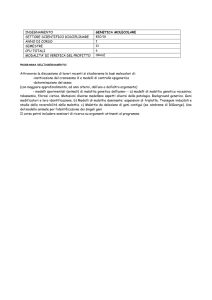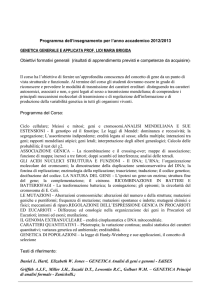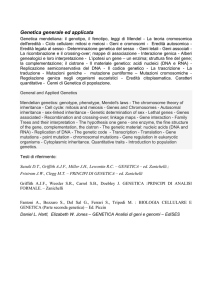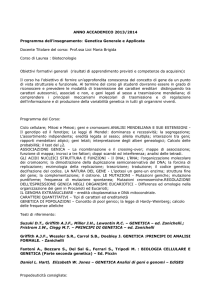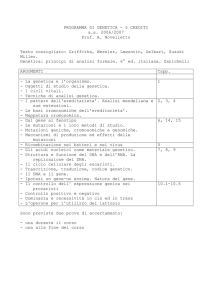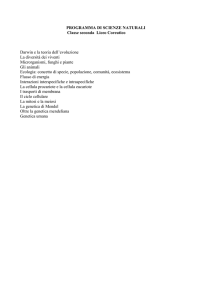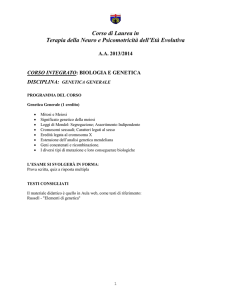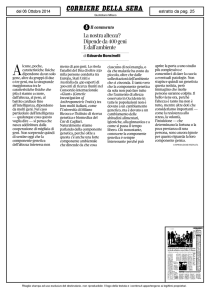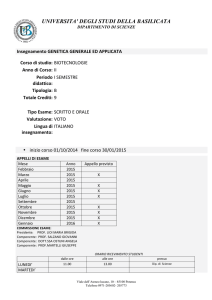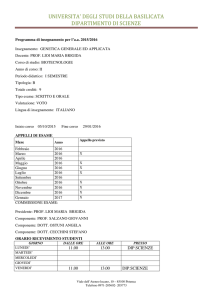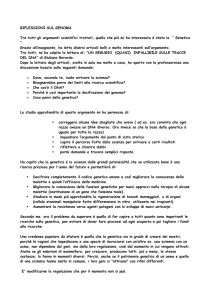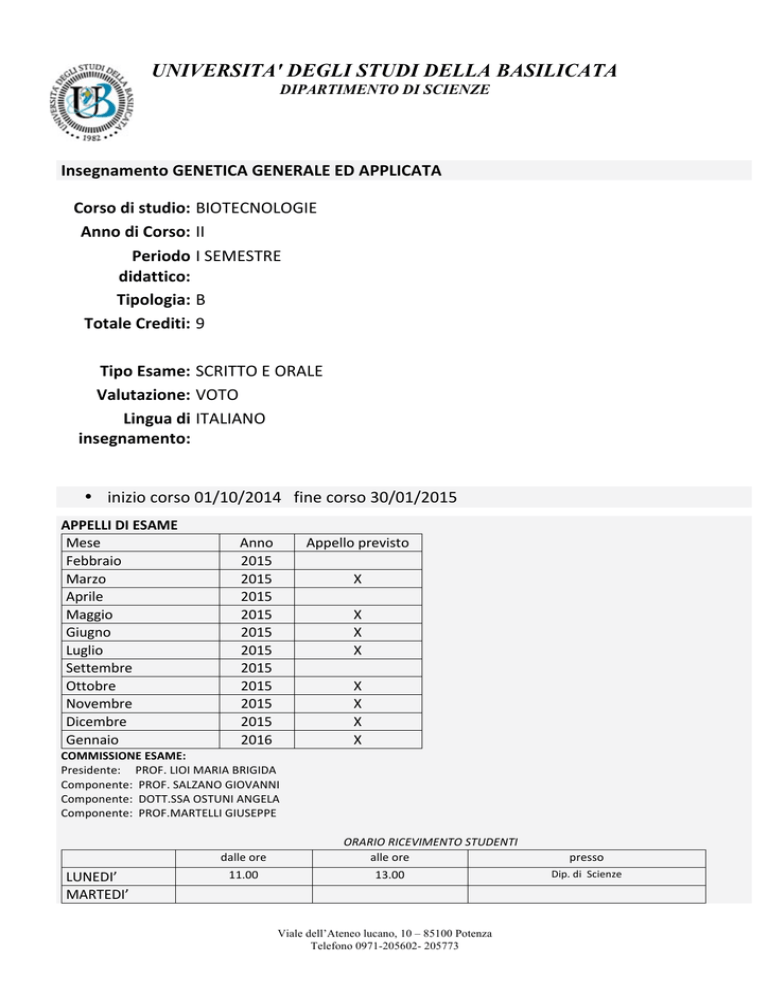
UNIVERSITA' DEGLI STUDI DELLA BASILICATA
DIPARTIMENTO DI SCIENZE
Insegnamento GENETICA GENERALE ED APPLICATA Corso di studio: BIOTECNOLOGIE Anno di Corso: II Periodo I SEMESTRE didattico: Tipologia: B Totale Crediti: 9 Tipo Esame: SCRITTO E ORALE Valutazione: VOTO Lingua di ITALIANO insegnamento: • inizio corso 01/10/2014 fine corso 30/01/2015 APPELLI DI ESAME Mese Febbraio Marzo Aprile Maggio Giugno Luglio Settembre Ottobre Novembre Dicembre Gennaio Anno 2015 2015 2015 2015 2015 2015 2015 2015 2015 2015 2016 Appello previsto X X X X X X X X COMMISSIONE ESAME: Presidente: PROF. LIOI MARIA BRIGIDA Componente: PROF. SALZANO GIOVANNI Componente: DOTT.SSA OSTUNI ANGELA Componente: PROF.MARTELLI GIUSEPPE LUNEDI’ MARTEDI’ dalle ore ORARIO RICEVIMENTO STUDENTI alle ore presso 11.00 13.00 Dip. di Scienze Viale dell’Ateneo lucano, 10 – 85100 Potenza
Telefono 0971-205602- 205773
UNIVERSITA' DEGLI STUDI DELLA BASILICATA
DIPARTIMENTO DI SCIENZE
MERCOLEDI’ GIOVEDI’ VENERDI’ 10.00 11.00 Dip. di Scienze Eventuali prerequisiti Obiettivi Formativi Il corso ha l’obiettivo di fornire un’approfondita conoscenza del concetto di gene da un punto di vista strutturale e
funzionale. Al termine del corso gli studenti dovranno essere in grado di riconoscere e prevedere le modalità di
trasmissione dei caratteri ereditari distinguendo tra caratteri autosomici, associati e non, e geni legati al sesso a
trasmissione mendeliana; di comprendere i principali meccanismi molecolari di trasmissione e di regolazione
dell'informazione e di produzione della variabilità genetica in tutti gli organismi viventi. Programma del Corso Genetica mendeliana: il genotipo, il fenotipo, leggi di Mendel - La teoria cromosomica dell'eredità - Ciclo cellulare:
mitosi e meiosi - Geni e cromosomi - Eredità autosomica – Eredità legata al sesso - Determinazione genetica del
sesso - Geni letali – Geni associati - La ricombinazione e il crossing-over; mappe di associazione – Interazione
genica - Alberi genealogici e loro interpretazione - L’ipotesi un gene – un enzima; struttura fine del gene; la
complementazione; il cistrone - Il materiale genetico: acidi nucleici (DNA e RNA) - Replicazione semiconservativa
del DNA – Il codice genetico - La trascrizione - La traduzione - Mutazioni geniche - mutazione puntiforme –
mutazioni cromosomiche - Regolazione genica negli organismi eucariotici - Eredità citoplasmatica - Caratteri
quantitativi - Cenni di genetica di popolazione.
Metodi didattici LEZIONE FRONTALE; ESERCITAZIONI NUMERICHE IN AULA Modalità di verifica dell'apprendimento ESAME FINALE Testi di Riferimento Suzuki D.T., Griffith A.J.F., Miller J.H., Lewontin R.C. – GENETICA – ed. Zanichelli.;
Fristrom J.W., Clegg M.T. – PRINCIPI DI GENETICA – ed. Zanichelli
Griffith A.J.F., Wessler S.R., Carrol S.B., Doebley J. GENETICA :PRINCIPI DI ANALISI FORMALE. – Zanichelli
Fantoni A., Bozzaro S., Del Sal G., Ferrari S., Tripodi M. : BIOLOGIA CELLULARE E GENETICA (Parte seconda
genetica) – Ed. Piccin
Daniel L. Hartl, Elizabeth W. Jones – GENETICA Analisi di geni e genomi – EdiSES Altre informazioni: UNIVERSITA' DEGLI STUDI DELLA BASILICATA
DIPARTIMENTO DI SCIENZE
COURSE General and Applied Genetics Course of Biotechnology studies: Academic Year: II ECTS: 9 Teaching Lectures; Exercises Methods: Evaluation Written and oral Methods: Evaluation: Score on 30 points Semester: I Language: ITALIAN • Course beginning on 01/10/2014 ending on 30/01/2015 Calls for examination Month February March April May June July September October November December January Year 2015 2015 2015 2015 2015 2015 2015 2015 2015 2015 2016 Examination Panel: President: PROF.LIOI MARIA BRIGIDA Member: PROF. SALZANO GIOVANNI Member: DOTT.SSA OSTUNI ANGELA Member: PROF. MARTELLI GIUSEPPE Expected call X X X X X X X X UNIVERSITA' DEGLI STUDI DELLA BASILICATA
DIPARTIMENTO DI SCIENZE
Previous requirements: Learning Outcomes:
The course has the objective to provide a thorough understanding of the concept of the gene from a stuctural and
functional point of view. At the end of the course students will be able to recognize and predict the mode of
transmission of hereditary characteristics distinguishing between autosomal, associated or not, and sex-linked
genes in Mendelian inheritance to understand the main molecular mechanisms of transmission and control
information and the production of genetic variability in all living organisms.
Syllabus: Mendelian genetics: genotype, phenotype, Mendel's laws - The chromosome theory of inheritance - Cell cycle:
mitosis and meiosis - Genes and Chromosomes - Autosomal inheritance - Sex-linked inheritance - Genetic
determination of sex - Lethal genes – Genes associated - Recombination and crossing-over; linkage maps - Gene
interaction - Family Trees and their interpretation - The hypothesis one gene - one enzyme, the fine structure of the
gene, complementation, the cistron - The genetic material: nucleic acids (DNA and RNA) - Replication of DNA The genetic code - Transcription - Translation – Gene mutations - point mutation - chromosomal mutations - Gene
regulation in eukaryotic organisms - Cytoplasmic inheritance - Quantitative traits - Introduction to population
genetics.
Suggested textbooks Suzuki D.T., Griffith A.J.F., Miller J.H., Lewontin R.C. – GENETICA – ed. Zanichelli.;
Fristrom J.W., Clegg M.T. – PRINCIPI DI GENETICA – ed. Zanichelli;
Griffith A.J.F., Wessler S.R., Carrol S.B., Doebley J. GENETICA :PRINCIPI DI ANALISI
FORMALE. – Zanichelli;
Fantoni A., Bozzaro S., Del Sal G., Ferrari S., Tripodi M. : BIOLOGIA CELLULARE E
GENETICA (Parte seconda genetica) – Ed. Piccin;
Daniel L. Hartl, Elizabeth W. Jones – GENETICA Analisi di geni e genomi – EdiSES; Further information: inform


